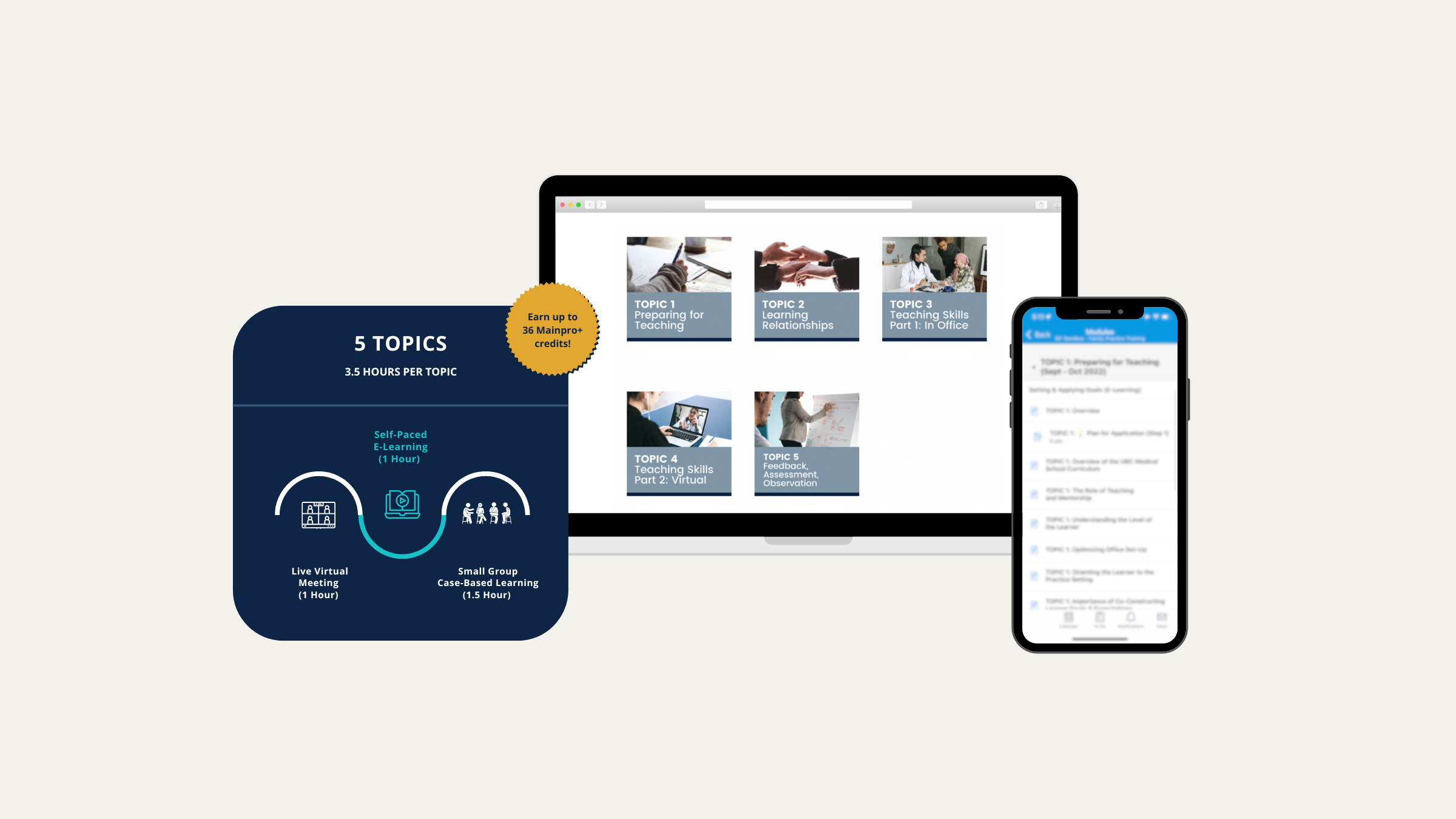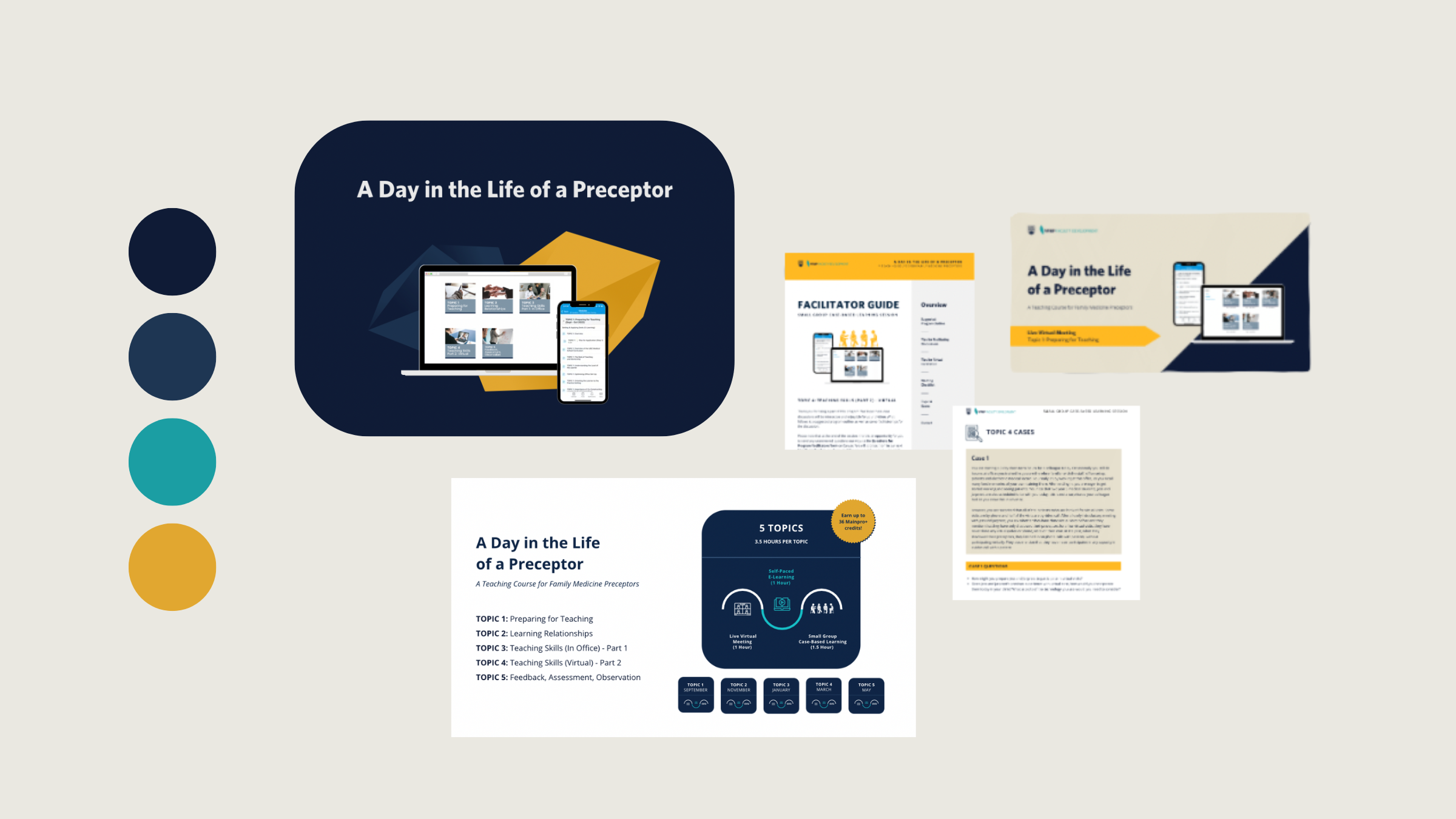
C A S E S T U D YCourse development
Project
Day in the Life: Crafting interactive professional engagement
Role
Lead Instructional Designer + Creative Producer
Challenge
Professional development programs in medical education faced barriers to engagement and complex processes that limited participation. Research had identified solutions, but the gap was execution. How do you transform academic insights into an engaging learning experience? I was brought in mid-development to craft something that would genuinely surprise and delight busy physicians, creating a deliverable that "set the standard for faculty development moving forward”.
Skills: Curriculum Design • Storyboarding • Content Development • Assessment Strategy • Learning Insights • Brand Alignment • Media Production
Translating academia into design solutions
R E S E A R C H T R A N S L A T I O NWorking alongside a cross-disciplinary team, I inherited comprehensive grant-funded research including environmental scans, literature reviews, and focus group reports. Rather than developing a basic course, I saw an opportunity to translate these insights into an elevated learning experience through visual design, brand storytelling, and creative production.
Key findings
Faculty desired engaging, mixed-media experiences over traditional lecture formats
Flexible, bite-sized content was essential for busy medical professionals
Peer connection and small group dynamics were critical motivators
Content needed to address real-world teaching challenges in digital environments
Design focus: Create a cohesive visual and interactive learning experience that elevates conventional training
Note: Proprietary course materials are not displayed per institutional confidentiality requirements. This case study documents the design methodology, strategic approach, and measurable outcomes. Visuals include public-facing content and privacy-protected examples.
D E S I G N A P P R O A C H
Crafting an instructional strategy
Working with busy physicians who needed flexible, relevant training, I applied adult learning principles with an experiential focus rooted in experiential learning theory (Kolb) and constructivist design.
Concrete experience
Designed patient simulation scenarios with branching decision trees and immediate consequence feedback
Reflective observation
Created structured debrief templates and peer review protocols to capture learning moments
Abstract conceptualisation
Developed concept mapping exercises linking clinical cases to evidence-based practice guidelines
Active experimentation
Built progressive skill-building activities with low-stakes practice opportunities before high-stakes assessments
L E A R N I N G A R C H I T E C T U R E
From drafts to pathways
Leading consultations with 7 faculty SMEs, I navigated varying levels of content readiness — from domain experts with existing materials to emerging topics requiring strategic development sessions. I guided busy physicians through brainstorming and content structuring, conducting multiple targeted meetings to develop robust content while respecting their limited availability.
Content architecture
Transformed dense SME drafts with extensive comments into visually structured content hierarchy
Cognitive load optimisation
Restructured fragmented SME notes into learning progressions with clear prerequisite relationships
Intuitive learning pathways
Created navigation pathways with completion tracking workarounds, enabling busy physicians to seamlessly resume learning
Multimodal asset development
Developed infographics, process diagrams, checklists, visual case study layouts, scenario-based decision trees, self-assessment tools and downloadable templates
C R E A T I V E P R O D U C T I O N
Delight in the serious
Based on faculty feedback requesting more engaging speakers and creative media use, I designed a brand system and produced a complete video series. This involved managing the full production pipeline from guest identification through final branded deliverables.
Visual Design & Brand Development
Approachability: Warm, welcoming aesthetic countering the sentiment of “grinding through” traditional training
Consistency: Cohesive visual language across all touchpoints
Accessibility: High contrast, readable typography, inclusive design practices
Media Production
Guest sourcing and interview coordination with 15+ medical professionals and students
Created 20+ storyboards in collaboration with SMEs
Conducted and recorded all interviews
Performed complete post-production: sound design, video editing, and color correction
Built templated visual assets for consistent brand application
R E F L E C T I O NOutcomes & Takeaway
Adoption: Successful pilot led to multi-year expansion across medical divisions
Engagement: Grew from 2 pilot groups to provincial rollout in 2 years (600% growth)
Recognition: Featured and presented at multiple national medical conferences since launch
We created a learning experience that exceeded traditional course development standards in both approach and content quality. A user-centered content architecture fostered authentic engagement, while designing for delight and humor built trust, overcame inertia, and reignited participants’ pride in the work.
Impact
By bridging academic research with user-centered design, my work helped:
Unlock development potential in conventional training contexts
Transform team vision through engaging storytelling and visual design
Set measurable standards that inspire approaches to professional education

